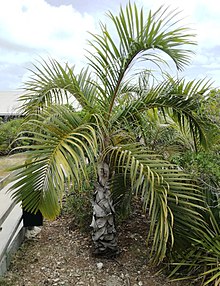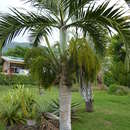Biology
provided by Arkive
The palmiste marron is monoecious, bearing both male and female flowers on the same plant (2) (3) (4) (8). The yellow flowers are unisexual (each flower possessing either male or female reproductive organs) and arranged in clusters, around 90 centimetres wide, that emerge from long, upward-pointing, horn-like bracts on the upper part of the trunk (2) (3). The flowers are said to have a sweet, delicate fragrance (6). The fruit of the palmiste marron is a rounded drupe, 2.5 centimetres wide, and is black when ripe (2) (3) (5).
Conservation
provided by Arkive
Conservation measures recommended for the palmiste marron and other endemic palms of the Mascarene Islands include fencing and weeding of areas of native forest to protect the remaining wild palms, as well as propagating species and re-introducing them into the wild, and undertaking further biological research (7) (8). It will also be important to involve local communities, with education programmes, incentives from tourism and palm plantations, and stricter laws for cutting down palms (7). The palmiste marron needs to be protected from hybridisation with closely-related palm species, and legislation is needed to ban the introduction of non-native palms to Rodrigues. Palms that have already been introduced will also need to be removed, although this has proved difficult to date because most are being grown in private gardens (7). Without a long-term conservation programme, this unique and Critically Endangered palm is in great danger of becoming extinct in the wild (8).
Description
provided by Arkive
The palmiste marron is a solitary palm with a distinctive grey, spindle-shaped trunk that bulges in the middle (2) (3) (4) (5) and has ring-like markings (6). A smooth, waxy, bluish-grey crownshaft, up to 90 centimetres tall and swollen at the base, emerges from the top of the trunk (2) (4). The leaves of the palmiste marron are large, at 1.8 to 3 metres in length, and pinnate, with 30 to 50 pairs of rigid, dark green leaflets which measure around 60 to 80 centimetres in length (2) (3). The leaf stalk is yellow (3).
Habitat
provided by Arkive
This palm is reported to occur in scrub forests and savannas, and to grow in limestone areas (1) (2).
Range
provided by Arkive
The palmiste marron is endemic to the island of Rodrigues, in the Indian Ocean, where it occurs in only 17 locations, including Grand Montagne, Anse Quitor and Ravine de la Cascade, St Louis (1) (5) (7) (8).
Status
provided by Arkive
Classified as Critically Endangered (CR) on the IUCN Red List (1).
Threats
provided by Arkive
Although widely cultivated as an ornamental palm (1) (5) (7), the palmiste marron is the second rarest palm on Rodrigues, with fewer than 60 individuals left in the wild, and little if any natural regeneration occurring on the island (1) (7) (8). The main threats to the species are overgrazing by cows, sheep and goats, as well as invasion by non-native plants, high levels of seed predation by rats, and severe fragmentation of the population (1) (7) (8). With such a tiny population, events such as cyclones can also have catastrophic effects on this palm (8). Although the palmiste marron is being increasingly cultivated on Rodrigues, to be planted as part of a habitat restoration project, there is a threat of hybridisation with the introduced palm Hyophorbe lagenicaulis (1) (7) (8).
Hyophorbe verschaffeltii
provided by wikipedia EN
Hyophorbe verschaffeltii, the palmiste marron or spindle palm, is a critically endangered species of flowering plant in the family Arecaceae. It is endemic to Rodrigues island, Mauritius, but is widely grown in cultivation.
Description

The trunk of
Hyophorbe verschaffeltii starts to swell in the middle, but becomes thinner with age.

The foliage of young plants can sometimes have a yellowish colour
The spindle palm is 6 metres (20 ft) tall, and have lightly recurved pinnate leaves.[2] They are elegant looking and are prized for landscape in the tropical and semi-tropical areas of the world. They are fairly short with 8–10 leaves that are held somewhat erect. Spindle palms have a crownshaft that becomes a light gray-green as the palm ages. Horn-like flower spikes emerge from below the crownshaft on mature specimens. Their fruits darken to a black colour when ripe. It was named after Ambroise Verschaffelt (1825–1886).
It sometimes resembles its closest relative, the "bottle palm" (Hyophorbe lagenicaulis). Both of these species develop swollen trunks. However the spindle palm's trunk starts to swell in the middle (assuming the shape of a spindle). The bottle palm's trunk continues to swell at the base (often resembling the shape of a bottle). The spindle palm's foliage also has a more yellowish colour.[3]
Distribution
Spindle palms are endemic to Rodrigues island, Mauritius. It is threatened by habitat loss.[1] There are only fifty or so specimens left in the wild, although its survival as a species is guaranteed due to ubiquitous cultivation in tropical areas of the planet.
Cultivation

The fruits of the Spindle Palm are the smallest in the genus (1.2–1.9cm) and they darken to black when ripe.
Spindle palms are fairly cold intolerant. They are defoliated at 32 °F (0 °C) and may be killed at anything below that. If the palm does survive a freeze, the next few emerging leaves are stunted. Spindle palms grow in the US in south Florida and in isolated favored microclimates along the coastlines of the Tampa-St.Petersburg-Clearwater areas as well as the Cape Canaveral and Satellite Beach areas of central Florida. They do make good container plants that can be protected from a freeze.
References

- license
- cc-by-sa-3.0
- copyright
- Wikipedia authors and editors
Hyophorbe verschaffeltii: Brief Summary
provided by wikipedia EN
Hyophorbe verschaffeltii, the palmiste marron or spindle palm, is a critically endangered species of flowering plant in the family Arecaceae. It is endemic to Rodrigues island, Mauritius, but is widely grown in cultivation.
- license
- cc-by-sa-3.0
- copyright
- Wikipedia authors and editors

